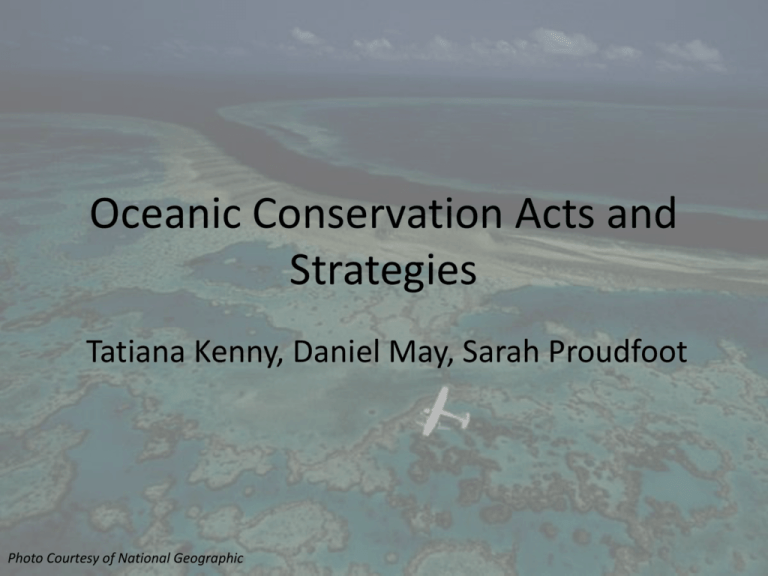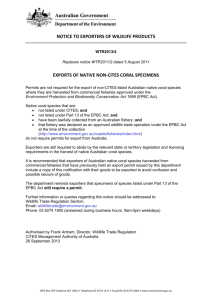
Oceanic Conservation Acts and
Strategies
Tatiana Kenny, Daniel May, Sarah Proudfoot
Photo Courtesy of National Geographic
Fishery Conservation and
Management Act
• Approved by Congress April 13, 1976
• Various amendments
• Protect our waters and our fishing resources
– Both foreign and domestic threats
– Overfishing
Goals of the Initial Act
• 200 mile fishery conservation zone
– Exclusive Economic Zones (EEZ)
• Regional Fishery Management Councils
– Federal, State, Fish and Wildlife Service
• Management of resources and foreign fishing
Driftnet Act Amendments of 1990
• Approved November 28, 1990
• Dangers of Driftnets
– Marine Mammals
– Nontarget Fish
– Sea Birds
• Driftnets beyond the EEZ
– Economic Sanctions and
Port Closures
Restoration of New England
Groundfish Amendment
• October 29, 1992
• Groundfish
– Cod, Pollock, Halibut
• Secretary of Commerce
Reimbursement of Sates
• Commercial Fisheries and
Underutilized Fisheries
– Northwest Atlantic Ocean Fisheries
Reinvestment Program
– New England Fishery Management
Council
Magnuson Stevens Fishery
Conservation and Management Act
• Largest Amendments – enacted October 11, 1996
• National Fishery Conservation Standards
– Participation of fishery dependent communities
– Minimize economic impact on fishery dependent
communities
– Minimize bycatch and bycatch mortality
• Modifies Fishery Management Councils
• Fishing Capacity Reduction Program
Magnuson Stevens Fishery
Conservation and Management Act
• Identification of overfished species and
rebuilding
• Identification of essential fish habitats
• Research on fisheries and their effects
– Conservation
– Economic
– Social
– Incidental Harvest of Other Species
Criticism
• Mostly ignored until Magnuson Stevens amendment
• Fishery Management Councils not well regulated
• Failure to slow overfishing
– Only three species back to maximum sustainable yield
– 72% of species are still below reference levels
• Failure to minimize bycatch
– Continue dangerous fishing practices
• Generally perceived as a failure because of previous
apathy
Coral in Alaska: Distribution,
Abundance, and Species Associations
Photo Alberto Lindner, National Oceanic and Atmospheric Administration (NOAA) Fisheries
Copyright © 2006 TerraNature Trust. All rights reserved.
Coral in Alaska: Distribution,
Abundance, and Species Associations
• Habitat Areas of Particular
Concern (HAPC)
– Living substrates
– Corals
•
•
•
•
•
©2005 California Academy of Sciences
Alcyonacea (Soft Corals)
Gorgonacea (Gorgonian Corals)
Scleractinia (Cup Corals)
Stylasterina (Hydrocorals)
Antipatheria (Black Corals)
Hawaii Undersea Research Lab,
via Dr. Scott France’s Web site at
the University of Charleston.
The Washington Post
Marine Conservation Biology Institute
Tree of Life Web Project
Coral in Alaska: Distribution,
Abundance, and Species Association
• National Marine Fisheries Service Trawl Data
– 1975-1998
• Commercial Fish Survey
• Areas Surveyed
– Gulf of Alaska (GOA)
– Aleutian Islands
– Bering Sea
Figure 1. Location of NMFS bottom trawl hauls
off Alaska, 1975 -1998.
Coral in Alaska: Distribution,
Abundance, and Species Association
Figure 3. Relative abundance within a taxonomic group of corals off Alaska based on
CPUE in NMFS trawl surveys, 1975 - 1998. Within a taxonomic group, CPUE was
scaled relative to the largest value.
Background for Coral Reef Conservation
• Rich in natural resources
• $375 billion in services
annually1
• Human actions harm
coral reefs
• 10% beyond recovery1
• 30% in critical condition1
1U.S.
National Action Plan to Conserve Coral Reefs
U.S. Coral Reef Task Force
• Established by President Clinton (1998)
• U.S. National Action Plan to Conserve Coral
Reefs (2000)
– Themes:
1. Understanding healthy reef maintenance
2. Reducing adverse impacts of humans on reefs
Local Action Strategies
• Ordered by Task Force in 2002
• Goals from National Action Plan
• Six threat areas:
1.
2.
3.
4.
5.
6.
Overfishing
Land-Based Pollution
Recreational Overuse
Public Awareness
Climate Change and Coral Bleaching
Disease
Source: Report on the Status of Local Action Strategies to Conserve and
Protect Coral Reefs for Years 2002-2006
Fisheries Local Action Strategy
• Overfishing
–
–
–
–
Definition
Selection of larger fish
Decline of herbivores
Overgrowth of algae
Source: University of Hawaii
• Destructive Fishing
– Damage by fishing gear
– Cyanide fishing
Source: Florida Department of Environmental Protection
LAS Successes and Future Work
• $24 million raised2
• Aquatic Invasive Species
Team in Hawaii
– Gracilaria salicornia
• Fisherman outreach
program
• $37 million deficit2
• Develop control
techniques for invasive
algae/plant new seagrass
• Assess distribution of
boat hull paint and its
impact on photosynthesis
Source: Hawaii DAR
2. Report on the Status of Local Action Strategies to Conserve and Protect Coral Reefs for Years 2002-2006
Contrasts in density, size, and biomass of
reef fishes between the northwestern and
the main Hawaiian islands: the effects of
fishing down apex predators
Alan M. Friedlander1, Edward E. DeMartini2
1The
Oceanic Institute, Makapuu Point/41-202 Kalanianaole Highway, Waimanalo, Hawaii
96795, USA
2National Marine Fisheries Service, Southwest Fisheries Science Center, Honolulu
Laboratory, 2570 Dole Street, Honolulu,
Hawaii 96822-2396, USA
Introduction
• Purpose: To contrast fish stocks in the remote
NWHI to the urbanized MHI.
• Hypothesis: The heavily-fished MHI will
contain fewer apex predators than the NWHI.
Source: Friedlander & DeMartini (2002)
Materials and Methods
• Study dates
– MHI: May 2000 – May 2001
– NWHI: September – October 2000
•
•
•
•
Underwater visual belt transect survey methods
Length of fish measured
Length converted to weight using W=aSLb
Species grouped into trophic levels
Results
Source: Friedlander & DeMartini (2002)
Results (cont.)
*
Source: Friedlander & DeMartini (2002)
Discussion
• Higher biomass in NWHI
– Reflection of productivity potential
• Higher predicted productivity in MHI
– Greater nutrient input, estuaries
• Lower herbivore biomass in MHI
– Impact of overfishing on trophic levels
National Marine Sanctuary Act
• Northwestern Hawaiian Islands managed by this act
• What is it?
• Why was it enacted?
• What does it entail?
Northwestern Hawaiian Islands
• When did they become a Marine Sanctuary?
• Why?
• How?
• What?
Northwestern Hawaiian Islands
(continued)
• What can or cannot be done in a marine
sanctuary?
• Where is the sanctuary located and how big is it?
• Main purpose of it being a marine sanctuary
• How will it be maintained?
Marine debris accumulation in the
northwestern Hawaiian islands:
An examination of rates and processes
Oliver J. Damerona, Michael Parkeb, Mark A. Albinsa, Russell Brainardb
a
Joint Institute of Marine and Atmospheric Research and NOAA Fisheries Pacific
Islands Fisheries Science Center, 1125B Ala Moana Boulevard, Honolulu, HI 96814,
USA
b Pacific Islands Fisheries Science Center, NOAA Fisheries, 1125B Ala Moana Boulevard,
Honolulu, HI 96814, USA
• Introduction
• Methods
– Used to maintain amount of debris found in the
Northwestern Hawaiian Islands
• Calculations
• Results
– The estimated amount of debris accumulated
after the clean up
• Discussion
References
http://www.sciencedirect.com/science/article/pii/S0025326X06005078#
http://sanctuaries.noaa.gov/about/legislation/
http://nodis3.gsfc.nasa.gov/displayEO.cfm?id=EO_13178_
http://www.fws.gov/laws/lawsdigest/FISHCON.HTML
http://www.nmfs.noaa.gov/sfa/magact/mag2.html#s206a
http://www.loe.org/images/content/060623/RosenbergsReport.pdf
Coral in Alaska: Distribution, Abundance, and Species Association
http://www.coralreef.gov/about/CRTFAxnPlan9.pdf
http://celebrating200years.noaa.gov/foundations/coral/side5.html
http://water.epa.gov/type/oceb/habitat/taskforce.cfm
http://www.coralreef.gov/about/members.html
http://www.coralreef.gov/las/lasreport20022006.pdf







